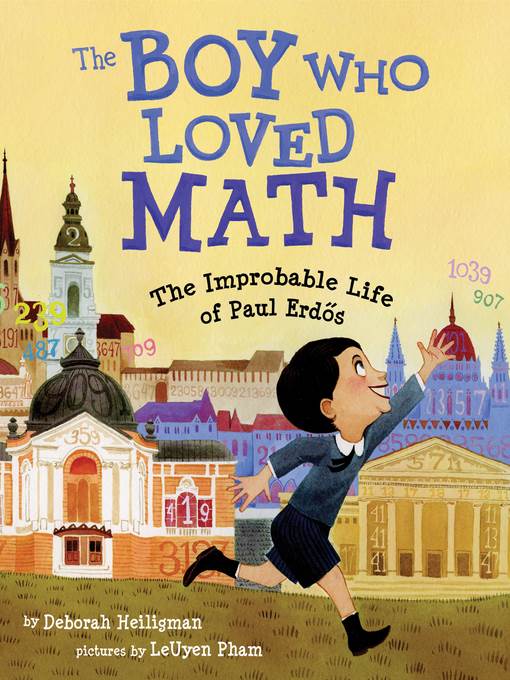
The Boy Who Loved Math
The Improbable Life of Paul Erdos
فرمت کتاب
ebook
تاریخ انتشار
2013
Lexile Score
550
Reading Level
2-3
ATOS
3.4
Interest Level
K-3(LG)
نویسنده
LeUyen Phamناشر
Roaring Brook Pressشابک
9781466839526
کتاب های مرتبط
- اطلاعات
- نقد و بررسی
- دیدگاه کاربران
نقد و بررسی

Starred review from June 3, 2013
As a boy in Budapest, Paul Erdos (1913–1996) had problems to solve, but they didn’t involve math. Rules were a problem, and school was another: “Paul told Mama he didn’t want to go to school anymore. Not for 1 more day, for 0 days. He wished he could take days away—negative school days!” Heiligman and Pham cleverly incorporate mathematical references through this story, which follows Erdos from a numbers-obsessed boy to a numbers-obsessed man who flouted societal norms and couch-surfed the globe—other mathematicians were honored to have him as a guest for the chance to talk math with him. Erdos’s unconventional brilliance shines through on every page, and extensive author and illustrator notes (including Pham’s explanations of the mathematical concepts she works into each illustration) will delight readers with even a fraction of Erdos’s interest in math. Ages 3–8.

Starred review from April 15, 2013
An exuberant and admiring portrait introduces the odd, marvelously nerdy, way cool Hungarian-born itinerant mathematical genius. Heiligman's joyful, warm account invites young listeners and readers to imagine a much-loved boy completely charmed by numbers. Paul Erdos was sweetly generous throughout his life with the central occupation of his great brain: solving mathematical problems. Unmoored from the usual ties of home and family once grown, he spent most of his career traveling the world to work with colleagues. Erdos was known for his ineptness at practical matters even as he was treasured, housed and fed by those with whom he collaborated in math. The polished, disarming text offers Pham free rein for lively illustration that captures Erdos' childlike spirit. She uses a slightly retro palette and line to infuse Erdos' boyhood surroundings with numbers and diagrams, conveying the idea that young Paul lived and breathed math. She populates his adulthood with his affectionate colleagues, even including a graph with Erdos at the center of several dozen of the great mathematical minds of the 20th century to illustrate the whimsical "Erdos number" concept. An extensive author's note includes a bit more biographical information about Erdos and points to George Csicsery's 1993 film N is a Number as well as to Heiligman's website for links for further exploration. Pham's illustrator's note invites young readers to go page by page to learn about the kinds of numbers that captivated Erdos and to meet him among his cherished mathematicians. Social learners and budding math lovers alike will find something awesome about this exceptional man. (Picture book/biography. 3-9)
COPYRIGHT(2013) Kirkus Reviews, ALL RIGHTS RESERVED.

May 1, 2013
Gr 3-6-Erdos (1913-1996), the Hungarian-born son of two math teachers, displayed his fascination with numbers early on. Before entering school he could calculate the number of seconds a person had lived just by asking the time and date of their birth. Unable to sit still and follow rules in school, he was homeschooled by his mother. High school was a better fit, and he made friends with students who shared his love of math. His skills became famous, but Erdos didn't know how to do laundry, cook, or even butter his own bread. He "didn't fit into the world in a regular way." So, he created a life that fit him instead. For years he flew around the world, his modest belongings in two suitcases, working with other noted mathematicians. They worked on number and set theory as well as new ideas like combinatorics and the probabilistic method. Some of their efforts led to the better computers and search engines that we use today. The well-researched text and painstakingly accurate illustrations (in terms of setting and mathematics) provide a fascinating introduction to the man. The oversize eyes of the characters give many of them, especially Erdos, a rather maniacal look that is off-putting. The extensive endnotes provide much information and would be useful in a classroom setting. That may be the most likely scenario for exposing children to this picture-book biography. Only the most mathematically devoted would pick it up on their own.-Sara-Jo Lupo Sites, George F. Johnson Memorial Library, Endicott, NY
Copyright 2013 School Library Journal, LLC Used with permission.

Starred review from June 1, 2013
Grades K-3 *Starred Review* Though eccentric mathematician Paul Erdos might seem an unusual subject for a picture book, his story makes for a memorable biography. Growing up in Hungary during WWI, Erdos tried school but chafed at the rules and convinced his mother that he should study at home. He was fascinated by numbers from an early age, and by the time he was 20, he was known as The Magician from Budapest. Unable to do common tasks such as cooking, laundry, or driving, he spent his adult life flying around the world, staying with other mathematicians, and working collaboratively on challenging math problems. Math is woven into the lively writing (Mama loved Paul to infinity. Paul loved Mama to 8, too!). The wonderfully vivid artwork, where ideas from the text are clarified, also uses decorative elements to support the idea that Erdos saw the world differentlynumerically. Heiligman appends a lengthy note about writing the book, while Pham offers a more extensive note on creating the illustrations, in which she comments on the mathematical ideas and mathematicians depicted in the art. This excellent picture-book biography celebrates a man little known outside his field, but one well worth knowing.(Reprinted with permission of Booklist, copyright 2013, American Library Association.)

























دیدگاه کاربران